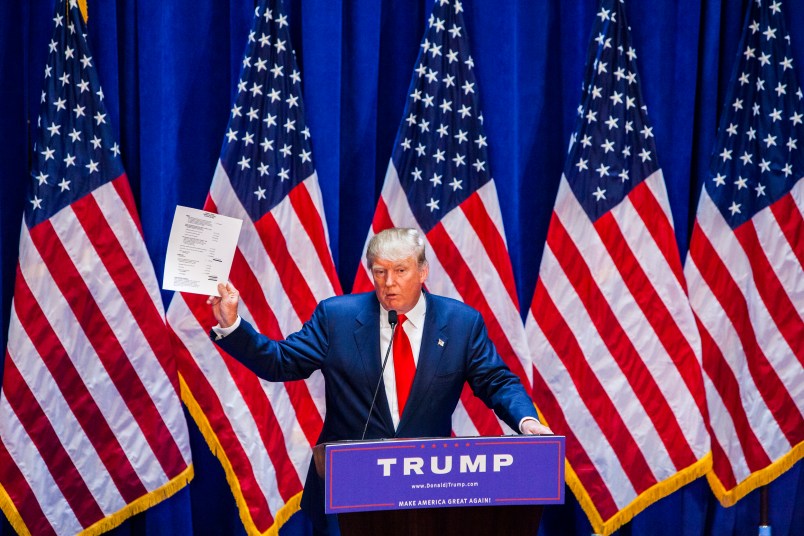A set of questions is coming into clearer view following the FBI searches at Mar-a-Lago on Monday: Were there classified records at former President Donald Trump’s residence? And, if so, what were they?
The answer to those questions alone wouldn’t necessarily reveal the extent of the alleged wrongdoing. Federal law prohibits the theft of government property, for example, regardless of whether the material is classified or not.
But the question of whether Trump mishandled classified national security information has gained new intensity following a Wall Street Journal report Tuesday afternoon that the FBI removed 10 boxes of material from Mar-a-Lago on Monday in a search for classified material.
Earlier on Tuesday, Trump attorney and former OAN host Christina Bobb confirmed in an interview that the warrant had to do with classified information.
“They also said that they were looking for classified documents, evidence of a crime as far as classified documents goes,” she said, recounting the visit by the FBI. “Classified information that they think should not have been removed from the White House as well as presidential records.”
For the past several months, Trump and those around him have thrown up various forms of chaff having to do with questions of classification.
It came after the National Archives told House Oversight Committee chair Rep. Carolyn Maloney (D-NY) in a February letter that it had identified “classified national security information” within 15 boxes of records that Trump turned over to the archives in January. Those boxes were full of presidential records that Trump had improperly taken with him from the White House.
It’s not clear what records “classified national security information” may refer to, though some experts suggested that the level of classification — combined with the apparent urgency of the FBI’s Monday searches — suggest it may have been something serious.
“As President, he had access to the most sensitive information that our government has,” former CREW counsel Anne Weismann told TPM. “Classified information is handled in a very specific and careful manner — it has to be stored, access is limited.”
Former Mueller prosecutor Andrew Weismann said on a Lawfare podcast on Tuesday that he could see evidence of Trump refusing to produce classified information to the National Archives as reason to launch the searches.
“This information had to be obtained and gotten back into the possession of the government,” he said. “I could see the issue of criminal prosecution being very, very secondary to the primary interest of the national security concern of needing to obtain the documents.”
When the National Archives first said in February that it had identified classified material, Trump replied by laying out a defense that he and his acolytes have used on the matter since: he was President, and therefore had unilateral authority to determine not only what was classified, but what needed to be stored as a presidential record.
“The National Archives did not ‘find’ anything, they were given, upon request, Presidential Records in an ordinary and routine process to ensure the preservation of my legacy and in accordance with the Presidential Records Act,” Trump said at the time.
Throughout the spring, reports indicate that the DOJ began to investigate the matter with some urgency. A grand jury was empaneled at some point in April, the New York Times reported. Four federal investigators, including the chief of the Counterintelligence and Export Controls Section of the DOJ’s National Security Division, reportedly visited Mar-a-Lago in early June.
As this all took place, one Trump loyalist who the former President empowered to negotiate with NARA over the matter made a little-noticed public assertion: Trump had already declassified everything that was at Mar-a-Lago — verbally.
“The White House counsel failed to generate the paperwork to change the classification markings, but that doesn’t mean the information wasn’t declassified,” Kash Patel, a former staffer for Rep. Devin Nunes (R-CA) and, briefly, a Pentagon employee, told Breitbart in May.
“I was there with President Trump when he said ‘We are declassifying this information,'” Patel added.
Per a 2009 executive order, markings on classified material need to be updated to reflect changes in their status.
“At a minimum they would have to be marked as unclassified,” Weismann, the former CREW attorney, told TPM.
It remains unclear what records may have been at Mar-a-Lago. Bobb, the Trump attorney, seemed to affirm that federal agents believed that some of the records were classified, but took the same line as Patel in arguing that Trump had already decided that the materials were neither classified nor presidential records.
Patel went on to suggest that Trump had been betrayed, but that his order to “declassify” should retain legal force.
“It’s petty bureaucracy at its finest, government simpletons not following a president’s orders to have them marked ‘declassified,’” Patel said. “The president has unilateral authority to declassify documents — anything in government. He exercised it here in full.”






